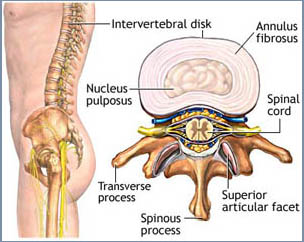What Causes the Pain?
Your spine must be stable to support upright posture, and also be flexible to allow you to bend and twist. This is mechanically very challenging and makes you spine vulnerable to injury.
The spine is made up of a system of bones called vertebrae, which are connected together by ligaments and muscle. The vertebrae surround and protect the spinal cord that has a consistency of cooked spaghetti. The spinal cord carries messages to and from your brain that control all your bodies' functions.

A disc separates each vertebrae and acts like a cushion, absorbing shock along the spine. The disc is made up of a jelly like substance known as the nucleus pulposis, surrounded by many strong outer layers called the annulus fibrosis.
Think of a jelly donut.
The annulus is the dough and the nucleus pulposis is the jelly.
The discs do not have a blood supply other the most extreme outer layers.
Therefore they have to rely on movement of the vertebrae to push nutrients in and out from above and below.
In addition, when we lay down at night to sleep, we partially diminish the effects of gravity and decrease the constant down ward pressure on the discs.
Therefore the outward pressure from within the disc is reduced. This allows fluids to seep back into the disc to re-hydrate and help rejuvenate the disc. This is why it is important to not sleep on your stomach.
Sleeping on your stomach increases the interdiscal pressure not allowing the disc to re-hydrate and recover from the days down ward pressure of gravity. This process is not very efficient, and as we age, the disc is exposed to wear and tear greater than its ability to heal and regenerate.
The discs are prone to injury and degeneration as they undergo compressive and twisting forces as a result of sitting, bending and lifting. In the lower levels of the lumbar spine, stress forces can equal 2.000 to 3,000 pounds of pressure per square inch. Repeated injury weakens the annulus (dough) and can cause the nucleus (jelly) to ooze out resulting in a herniation.
Repeated injuries ("muscle pulls") will result in the degeneration of the disc, which becomes stiff and dry, causing it to loose shock absorbing properties. This process may continue until the discs collapses, which increases the mechanical pressure on the bones and joints leading to a degenerative arthritic condition (spinal stenosis).
What can I expect from a typical treatment? >>